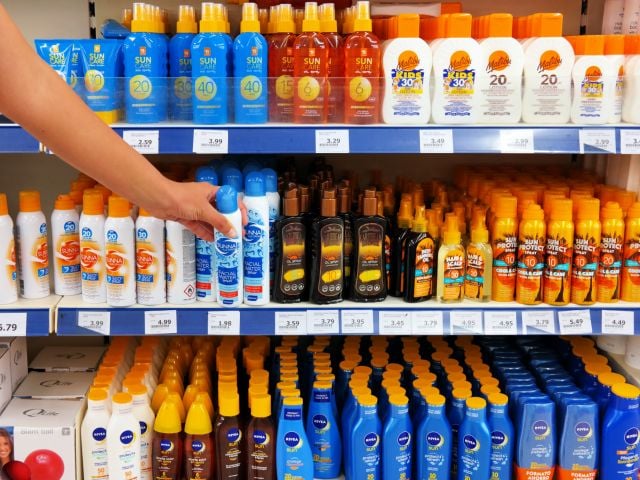Wearing sunscreen is one of the simplest and most important ways to protect your health. Skin cancer is the most common form of cancer in the United States, and it’s on the rise, with one in five Americans expected to develop it in their lifetime.
The good news? This year, EWG found almost 500 sun protection factor, or SPF, products that are safe and effective. The key is to find a sunscreen you’ll actually use consistently, along with practicing sun safety habits – seek shade, wear a hat and sunglasses, and avoid the sun during peak hours, between 10 a.m. and 4 p.m.
But here’s the problem: American sunscreens aren’t as safe or effective as they could be.
While countries in the European Union and Asia offer more advanced, broad-spectrum SPF products with modern ingredients, U.S. consumers are stuck with outdated products – many of which contain chemicals that may be harmful. We have neither protection from older, potentially unsafe chemicals nor access to newer ingredients that European and Asian tests have found to be safe.
How the process works in the U.S.
In the U.S., the Food and Drug Administration regulates sunscreens as over-the-counter drugs. This means regulation is much more restrictive here than in the EU and Asia – and it has slowed the approval of new ingredients that may be protective and safer.
The outdated system blocks innovation and the introduction of newer chemicals, even those that have been approved for use in Europe and Asia for more than a decade.
Currently, if a sunscreen is to be sold without a prescription, its ingredients must be listed in what’s called an OTC monograph – a kind of “recipe book” that outlines which substances are allowed, what concentrations are safe, how products must be labeled and what tests must be conducted.
That sounds reasonable. But this system hasn’t kept pace with modern science – the current monograph is outdated.
Regulations here restrict the quantities of some ingredients, like oxybenzone and homosalate, allowed in formulas. Current concentration limits were established in 1999 and have not been updated, despite evidence that they may pose certain health risks, such as absorption through the skin, hormone disruption and allergic reactions.
At the same time, newer and more effective sunscreen filters have been available in Europe and Asia for decades, after regulators determined that they are safe. But these ingredients are still not allowed in U.S. sunscreens. This is especially true of those that absorb ultraviolet radiation A, or UVA, rays, which are linked to skin aging and increased cancer risk.
Sunscreen ingredients shouldn’t make it to market without adequate FDA review. It requires comprehensive data from sunscreen makers, yet the already overstretched agency lacks the ability to speedily review ingredients even if they get that information.
And with the Trump administration proposing sweeping budget cuts for agencies, the FDA won’t have the resources it needs to improve and accelerate its unique process for pre-market review of sunscreen ingredients.
Outdated, painfully slow process
American consumers pay the price for the FDA’s outdated approach.
The agency began to regulate sunscreens in the 1970s – roughly 50 years ago. Updates have been delayed repeatedly. Between 2002 and 2009, sunscreen companies tried unsuccessfully to add new, safer ingredients.
Congress has tried twice to break this impasse. In 2014, it passed the Sunscreen Innovation Act. In 2020, it passed the CARES Act, which replaced the slow regulatory process with a faster system.
Despite those legislative efforts, the FDA still hasn’t finalized a sunscreen order that would update U.S. sunscreen regulations. That delay has real consequences. It means outdated and concerning ingredients, such as oxybenzone, remain on the market, while many promising new ingredients remain off-limits in the U.S.
Under the proposed sunscreen order, products containing zinc oxide and titanium dioxide are considered generally recognized as safe and effective, or GRASE.
Sunscreens containing aminobenzoic acid and trolamine salicylate are not considered safe and that’s because of data showing potential health risks. Meanwhile, sunscreens with any of a dozen ingredients have not been granted GRASE status, because there isn’t enough data to confirm their safety.
These ingredients remain in regulatory limbo: cinoxate, dioxybenzone, ensulizole, homosalate, meradimate, octinoxate, octisalate, octocrylene, padimate O, sulisobenzone, oxybenzone and avobenzone.
Companies producing these filters have refused to give the FDA the data it needs to determine what is safe.
How the EU and Asia regulate SPF products
Sunscreens make health and efficacy claims, and regulations for them vary around the world.
If you’ve ever wondered why some sunscreens from Europe or Asia feel lighter, blend better, don’t have SPF numbers over 50 and tout stronger UVA protection than those sold in the U.S., the answer lies in how they’re regulated.
In the EU, sunscreens fall under the Cosmetics Regulation, which governs all cosmetic products sold across the bloc. That means sunscreens are treated more like moisturizers or serums than like drugs.
Only ultraviolet filters that appear on the EU’s approved ingredient list can be used, and there is a strict maximum concentration for each. The EU currently allows more than two dozen filters that aren’t available in the U.S. Some, such as bemotrizinol and bisoctrizole, are highly effective.
When it comes to sun protection claims, the EU has firm guidelines. Any product that says it offers UVA protection must reach a specific threshold: The UVA protection factor must be at least one-third of the SPF value.
Products that meet this standard can carry the official EU UVA logo to assure consumers they’re getting broad-spectrum protection. The EWG Verified® program also requires this, along with results from other stringent tests.
But at the same time, because they are regulated as cosmetics in the EU, sunscreens may lack comprehensive safety data related to human health impacts if they are absorbed into the body through the skin. Sunscreen filters can be marketed as cosmetics in the EU with those data gaps, but the U.S. over-the-counter drug process presents a barrier to entry. So far, only one company is developing the data needed to get U.S. approval.
Across Asia, sunscreens are regulated more like therapeutic products, falling into categories like “functional cosmetics” or “quasi-drugs.” That means they often require government review and approval before being sold.
For example, in Japan, sunscreens are classified as quasi-drugs and must be approved by the Ministry of Health, Labour and Welfare. This includes submitting data on efficacy and safety.
In South Korea, sunscreens are labeled as functional cosmetics and overseen by the Ministry of Food and Drug Safety.
But these regulatory processes in Asia have not required sunscreen companies to develop the kinds of human health safety data requested by the FDA.
As a result of these different regulatory processes, the EU and many Asian countries have authorized a broader range of UV filters than the U.S. Companies in those markets may formulate sunscreens with more comprehensive UVA and UVB protection, often with more appealing textures and fewer white casts.
For consumers, this means that a sunscreen purchased abroad might provide better protection or a more pleasant user experience than many of the products available domestically.
Why ingredients safety matters
Sunscreen filters should protect against both UVA and UVB rays – and do so without compromising your health.
But many U.S. sunscreen ingredients fall short.
Most American sunscreens don’t effectively block UVA rays, which penetrate deeper into the skin and are strongly linked to skin cancers like melanoma. An EWG study found that many sunscreens provide only a fraction of the UVA protection their SPF labels suggest – sometimes as little as 24%. This means consumers may be far less protected against aging, immune damage and skin cancer than they think.
These findings support a 2019 FDA study that called current U.S. sunscreen standards inadequate and suggested a focus on stronger UVA protection rather than higher SPF numbers.
Some common chemical filters, like oxybenzone, have been detected in blood, urine and breast milk, and may interfere with hormone function, a particular concern for children.
What must change
Here’s what consumers deserve, and what Congress and the FDA should do:
- Finalize the sunscreen rules. The FDA proposed its new sunscreen order in 2021, but it hasn’t been finalized. Without final rules, the market remains stuck with outdated products. Congress should require the FDA to finalize these rules within six months of the next reauthorization of the OTC drug user fee program.
- Fund the FDA to do the job. Congress must ensure that the FDA has the scientists, staff and other resources to review safety data, assess ingredient toxicity and conduct its own studies when companies fail to provide enough data.
- Level the playing field for new ingredients. Old ingredients are currently allowed to stay on the market with little data to support their safety, while newer, possibly safer ones are blocked because of insufficient testing. Congress should consider conditional, time-limited approval of promising new ingredients while data is being developed.
And Congress should require user fees to allow the FDA or other qualified third parties to fill in data gaps for both newer and existing sunscreen ingredients.
- Support real safety tests. To approve or reject sunscreen ingredients, the FDA needs access to rigorous studies – like maximal usage trials, which measure how much of a chemical the body absorbs. Congress should support, not weaken, the FDA's authority to require these studies.
- Remove harmful or unsupported ingredients. If an ingredient lacks safety data or shows potential harm – like hormone disruption or toxicity – it should be pulled from store shelves.
- Fix SPF label confusion. High SPF numbers can give a false sense of security. SPF measures UVB protection only. The FDA should strengthen SPF labeling rules to help consumers make informed choices and avoid overexposure to harmful rays.
- Prioritize safer forms of ingredients. For example, rutile titanium dioxide is much safer than anatase titanium dioxide, which is more likely to cause skin damage when exposed to sunlight. The FDA should make this distinction in its regulations.
- Ensure safe spray and powder sunscreens. The FDA should finalize rules that require particle-size analysis of sprays and powders to prevent lung exposure to tiny particles that could be inhaled.
Americans deserve better sunscreen
It’s time for regulators catch up with the science. We need sunscreen products that are safe and effective and based on robust, transparent data. Consumers should be able to trust that what they put on their skin protects them from cancer without creating new health risks.
Congress and the FDA must act not just to update outdated rules but to ensure a sunscreen market that reflects the latest in health science, consumer safety and public trust.



